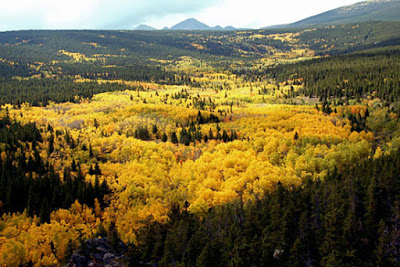Environment & Energy
Related: About this forumAn Enormous "Blob" In Utah Is Up To 80,000 Years Old And Among Earth's Oldest Organisms
Pando covers 42.6 hectares, and its name means “I spread”.
Rachael Funnell
Writer & Senior Digital Producer
- click link for images -
https://assets.iflscience.com/assets/articleNo/80077/aImg/85233/pando-l.webp
An aerial view of Pando the “I spread” aspen doing what it does best.
Image Credit: Lance Oditt, CC BY-SA 4.0, via Wikimedia Commons
A massive blob lives in Utah, and its name is Pando, which literally means “I spread”. The sprawling lump of quaking aspen (Populus tremuloides) has lived up to its name in spreading across 42.6 hectares (105.3 acres) in Fishlake National Forest with a network of 47,000 stems that were created through asexual reproduction, essentially making Pando a giant tangle of clones. That means it’s technically a single tree, one of the largest organisms on Earth, and we now know it’s one of the oldest, too.
A preprint looked at Pando's genetic data and concluded that its age ranges between 16,000 and 80,000 years old. While clones are exact copies of each other, they can still independently develop different genetic mutations as they divide, so the team was also excited to see what its genetic variation could reveal about the secret to living a long and massive life.
Pando’s sexless life is the result of being triploid, which means it has three copies of each chromosome in its cells instead of two. Sexual reproduction off the cards, Pando instead clones itself, but it may be a perk for longevity as the researchers say triploid could mean “bigger cells, bigger organisms, better fitness” – good news for something that's slowly being eaten by deer.
From one seedling to tens of thousands of iterations, Pando has put in quite the shift and the scientists were curious to see what changes have unfolded in its many stems. Curiously, this kind of genetic variation in a clonal animal is something that nobody had really studied in Pando before.
More:
https://www.iflscience.com/an-enormous-blob-in-utah-is-up-to-80000-years-old-and-among-earths-oldest-organisms-80077

Pando aspen grove at Fishlake National Forest
Pando Wikipedia:
https://en.wikipedia.org/wiki/Pando_%28tree%29



intrepidity
(8,522 posts)Am very please to discover it is Aspens, though
AllaN01Bear
(27,874 posts)stage left
(3,159 posts)For a blob.
Heard of this on the marvelous British TV quiz show "QI" (Quite Interesting) some time ago but I've never looked it up.
Amazing!
BurnDoubt
(1,188 posts)There is so much still to be known about EVERYTHING.
We won't get there if we choose Ignorance.
"Good Morning, Good Simpleton."
FoggyLake
(305 posts)this is much better
2naSalit
(98,509 posts)It is NOT the deer who are eating all the young sprouts! It would not have survived if the deer were doing this kind of damage. There is cattle grazing in that forest and it's the fucking COWS who eat the vegetation to the ground because that's what they do, especially when the livestock owner puts more than the allowed number of cows on their allotment. The exclosure, the fenced off area he showed early in the video, is from a study but it isn't to study the management of the deer, it's about keeping out everything, especially COWS.
The majority of destruction to our national forests, after humans via logging, mining, their atvs and other toys, is done by cows. Poor management of humans and their use of the land is the biggest threat to Pando and all other life on the planet.
We, as a species, need to manage ourselves not the environment around us.
et tu
(2,387 posts)bet those 'techbrocrats' will be looking for longevity
and yes indeed ranchers want to rake in as much $$$
as they can for their grazers and that is also why in
the west they want to get rid of wild horses,burros and
donkeys. deer are browsers like goats.
PufPuf23
(9,657 posts)Coast redwood most frequently reproduces by coppice (by sprouting) like quaking aspen.
Commercial and other planted redwoods are overwhelmingly clones. Redwood seeds are small and hard to handle and have very low viability but natural redwood seedlings do occur in nature. Redwood is one of only 3 conifer species with polyploid chromosomes.
Polyploid plants tend to live longer and get larger. Developing polyploid strains has long been a commercial tool as in breeding high yield varieties of rice and wheat.
Pando is definite cool and beautiful and have no argument with post nor video. Post to fill in some detail.
Coast Redwood May be the Descendent of Two
cut
Polyploid organisms have more than two sets of each of their chromosomes, packages of DNA that hold recipes for making proteins. The human cell contains pairs of chromosomes. We have two copies of 23 chromosomes in every cell. The coast redwood, on the other hand, has a rare makeup of six copies of each chromosome, making it a hexaploid. Polyploidy is relatively common among flowering trees, but rare among gymnosperms, or cone bearing trees. The coast redwood is one of only three polyploid conifers in the world.
But ancestors of the coast redwood all have paired chromosomes, so how did it evolve into a hexaploid? Ahuja and Neale used a variety of methods to compare the giant tree to other members of its family. These include analyzing fossil patterns, physical characteristics, embryonic development patterns, pictures of chromosomes, the structure of molecules within cells, and the structure of pollen and stomata (cells in the epidermis that function much like human sweat glands by releasing water). Their work reveals that the coast redwood is most closely related to the dawn-redwood (Metasequoia) and the giant sequoia (Sequoiadendron) and that these three are more closely related to each other than they are to other members of their family.
Their results suggest that the coast redwood most likely became a hexaploid in the Cretaceous period (~144 – 65 million years ago) in one of three ways: the number of chromosomes per set multiplied in one ancestor, the genomes of two ancestors hybridized to yield additional sets, or the genomes of three ancestors hybridized.
“The current working hypothesis is the two-ancestor option,” says Dr. Neale.
cut
https://www.savetheredwoods.org/grant/coast-redwood-may-be-the-descendent-of-two/
Why are triploid quaking aspen (Populus tremuloides) common?
Premise: Quaking aspen is a clonal tree species that has mixed ploidy, often with high relative abundance of both diploids and triploids but no haploids or tetraploids. Triploids typically have low fertility, leaving their occurrence apparently unlikely from an evolutionary perspective, unless they provide a "triploid bridge" to generating higher-fitness tetraploids-which are not observed in this species. This study focused on how triploidy can be maintained in quaking aspen.
Methods: A computational model was used to simulate gamete production, sexual reproduction, asexual reproduction, parent survival, and offspring survival in a population. All parameters were assumed to be cytotype-dependent and environment-independent. Sampling methods were used to identify parameter combinations consistent with observed cytotype frequencies.
Results: Many processes and parameter values were sufficient to yield a moderate frequency of triploids, and very few were necessary. The most plausible route involved higher triploid survival at the parent or offspring stage and limited unreduced gamete production by either diploid or triploid parents. Triploid fertility was helpful but not necessary.
Conclusions: The coexistence of diploids and triploids in quaking aspen is statistically likely and promoted by the existence of commonly observed, long-lived triploid clones. However, other mechanisms not captured by the model related to environmental variation could also occur.
https://pubmed.ncbi.nlm.nih.gov/38704729/